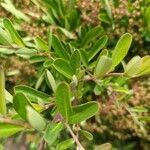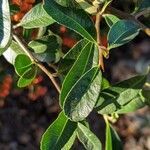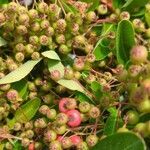Plants 5–40 dm. Stems: thorns sparse to abundant; young twigs reddish brown-hairy, glabrescent. Leaves: stipules 3–8 mm; petiole 1–3 mm; blade oblanceolate or narrowly obovate, 2.5–4.5 × 0.5–1.2 cm, base cuneate, margins entire, rarely with minute teeth near apices, apex truncate or retuse, rarely rounded, abaxial surface brown-hairy, becoming glabrate and pale green, not glaucescent, adaxial glabrous. Inflorescences 3–4 cm diam. Pedicels 5–12 mm, sparsely brown-hairy. Flowers 8–10 mm diam.; hypanthium densely hairy; ?calyx brown-or yellowish brown-puberulent when young, glabrescent?, sepals triangular, 1–1.3 mm, apex acute; petals suborbiculate, 3–4 mm, apex slightly emarginate. Pomes orange-red, 4–7 mm diam.; pedicels 5–13 mm.
A shrub. It grows 3.5-4.5 m high and spreads 3.5 m wide. It has many branches. The young stem are reddish and have a down. They become smooth and purple. The leaves are dark green and glossy above but paler underneath. The flowers are small and white. The fruit is a berry. The colour can vary but they are often orange or scarlet.




